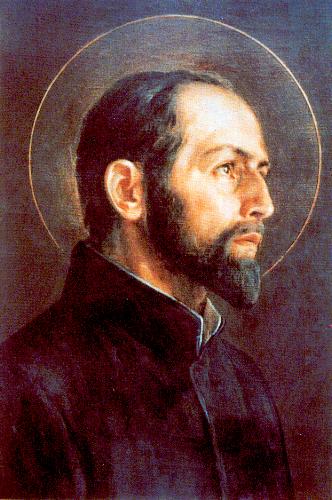Saint Anthony Zaccaria
Saint Anthony Zaccaria, Priest
1502–1539
In thirty-nine niches in the nave and transepts of St. Peter’s Basilica in Rome are  thirty-nine statues of saints who founded religious congregations. Some of these saints are very well known, like Saints Benedict, Ignatius of Loyola, and Teresa of Avila. Today’s saint is among the lesser-known founders. The statue of Saint Anthony Zaccaria looks down from a second-tier niche, high above the Basilica floor. Saint Anthony’s distance from the faithful in art reflects his relative remoteness from modern life. Not every saint can be a rock star. The Church preserves the legacy of this holy man on its universal calendar, though, for very solid reasons.
thirty-nine statues of saints who founded religious congregations. Some of these saints are very well known, like Saints Benedict, Ignatius of Loyola, and Teresa of Avila. Today’s saint is among the lesser-known founders. The statue of Saint Anthony Zaccaria looks down from a second-tier niche, high above the Basilica floor. Saint Anthony’s distance from the faithful in art reflects his relative remoteness from modern life. Not every saint can be a rock star. The Church preserves the legacy of this holy man on its universal calendar, though, for very solid reasons.
Saint Anthony was born in Northern Italy just as the powder keg of the Protestant Reformation was about to ignite. He studied medicine and became a practicing physician. But his real love was people’s souls, not their bodies, and he dedicated most of his time to teaching the catechism to the poor. Like so many priestly vocations, others recognized his gifts before he saw them himself. Friends and family encouraged him to study for the Priesthood. Saint Anthony was ordained in 1528 and soon moved to the bustling city of Milan. He became a roving chaplain to nobles and to diverse lay groups committed to charitable works and to invigorating Milanese society with an authentic Catholic spirituality.
Along with two noblemen, Saint Anthony founded a Congregation of priests whose goal was to “regenerate and revive the love of divine worship and a properly Christian way of life by frequent preaching and faithful ministering of the sacraments.” There is nothing new, creative, or groundbreaking in such goals. But as would be highlighted a few decades after Saint Anthony by Saint Charles Borromeo, the vigorous Archbishop of Milan, Northern Italy in the sixteenth century was in a state of religious decrepitude. Today’s saint and his co-founders needed to found a Congregation to blow life into the dormant coals of people’s faith and to rekindle their love of the Mass and the Holy Eucharist. No one else was carrying out these fundamental evangelical tasks. The secular clergy were moribund, and bishops often did not even reside in their dioceses. Someone had to do something, and thus the “Clerks Regular of Saint Paul Beheaded” was born and formally recognized in 1535. The Congregation’s members became more commonly known as the Barnabites after a Church in Milan where they were eventually headquartered or perhaps due to Saint Barnabas’ status as one of Saint Paul’s closest companions. The Barnabites encountered fierce opposition from local clergy who were offended by the imputation that they were derelict in their duties and needed reform. These internecine knife fights were quickly settled in the Barnabites’ favor.
Saint Anthony popularized the Forty Hours Devotion, where the Blessed Sacrament is exposed over a three-day period corresponding to Christ’s forty hours in the tomb. He encouraged churches to toll their bells on Friday afternoons, and preached indefatigably in the streets on the crucifixion, on the Eucharist, and on the texts of Saint Paul. The age for scholastic theological distinctions as fine as lace had long ended by the early sixteenth century. The one-church world was crumbling and with it the luxury of inter- Catholic speculations of a purely theoretical nature. Dissenting Protestantism was spilling into Northern Italy. What was needed was preaching in the streets, raw fervor, and the core biblical message. Some priests spoke with quiet erudition and convinced the few, others explained the catechism well, but only inside churches to the scattered faithful in the pews. Saint Anthony’s method was, essentially, to walk into the town square, light his hair on fire, and yell “Watch me burn!” It worked—but not for long enough. Saint Anthony Zaccaria flamed out at the early age of thirty-seven. He was canonized in 1897, and his remains are venerated today in the crypt of the Barnabite church in Milan. The Congregation he founded is of modest size yet still vigorously serving in the heart of the Church.
(excerpted from mycatholic.life)
Mass Readings: July 05, 2020